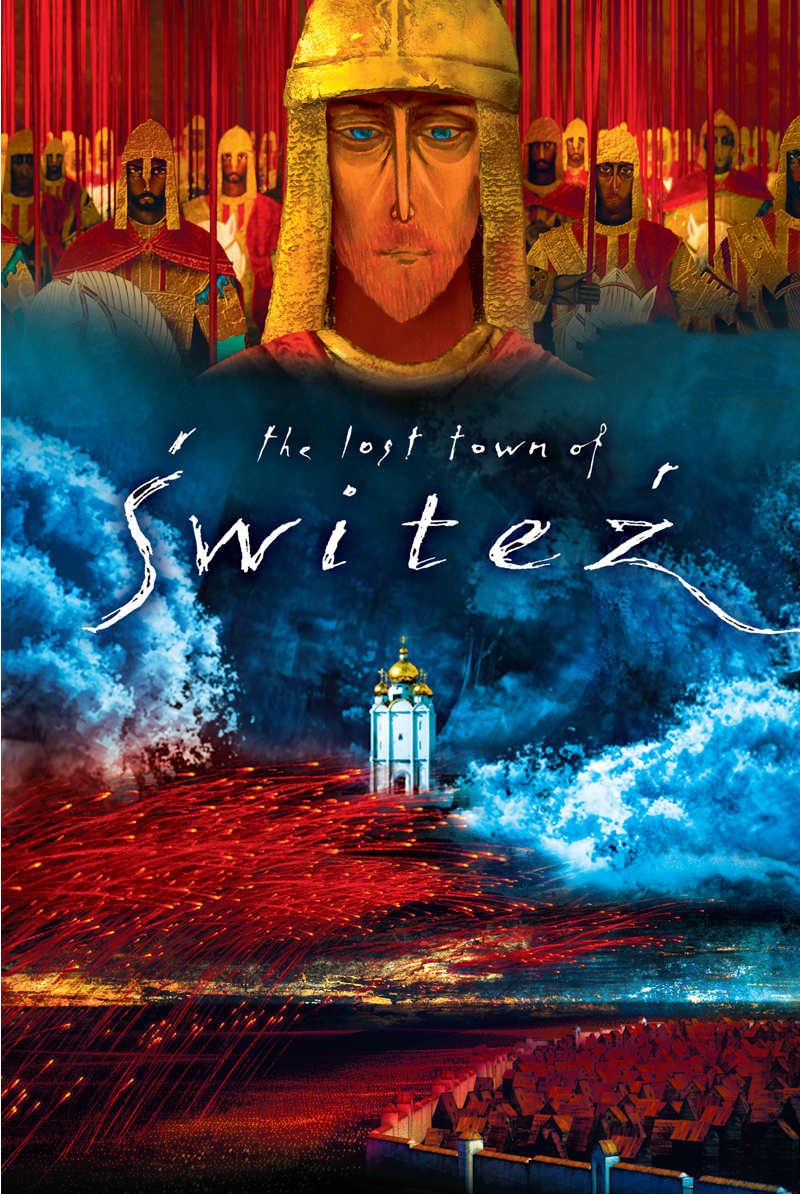| ________________
CM . . .
. Volume XX Number 12. . . .November 22, 2013
As The Lost Town of Switez opens, a coach speeds through the Polish countryside of the 19th century, the horses neighing wildly. The sun is setting, and a full moon rises overhead. Suddenly, the coach stops, and the young man who is its lone occupant emerges, lights a lamp and steps out into the dark woods around him. Deep in sleep, the coachman snores, and the horses stand stock still. Suddenly, a bright flame whizzes by the young man’s head – at first, the sky seems lit by a meteor shower, but then, a brigade of cavalry storms out of the woods, shooting flaming arrows which set the woods ablaze. As quickly as they have appeared, the horsemen vanish. The young man finds himself at the edge of a clearing, takes a few steps backward, and then, falls into a pond. But, rather than drowning, he tumbles down a long tunnel, and shafts of light begin to illuminate the darkness. Dense evergreens give way to a vista of a city perched on a hill, surrounded by ripening fields. A church stands atop that hill, and from its bell-tower comes the toll of a single bell. Two large crowds stand outside the church: ranks of lance-bearing cavalry, dressed in the armor of medieval knights, and the town’s citizenry, dressed in the simple garb of those who labor on the land. The images bear the flat, two-dimensional quality of Byzantine art. The lancers, the town’s defenders, ride off slowly. As a choir sings “Hospode Pomelu” (Polish for “Lord, have mercy”), viewers see images of townsfolk sitting alone in their tiny rooms or praying by the light of a single candle As they pray and entreat the Almighty, a fierce battle rages beyond, and soon the field is littered with the bodies of men and their mounts. The victors ride towards the town, stop outside its gates, and unleash a volley of flaming arrows, setting the town aflame. The church is the only sanctuary, and, as the young man flees to its safety, he stops for a moment outside, views the approaching inferno and the invaders thundering through the town’s gate. The people wait and pray in silence as the army pounds on the church doors. The doors fling open, and the congregation sees their world ablaze. But, as they turn back towards the altar, its icons being the church’s only sources of light, as if by some miracle, a vision of a bright and beautiful new city slowly emerges, protected by hosts of angels, and the iconic image of Christ the Pantocrator (the Ruler of All). Outside the church, an earthly hell rages, with flames and a raging army threatening all. But, then, torrents of water coalesce into a deluge which douses the fires. The church continues to stand, and the waters recede. Just as in the Biblical account of the Great Flood, life returns to the world. The consoling single flames of the church’s candles metamorphose into water lilies which shine in golden sunlight. And the young man rises to the top of the pond, clutching the flowers. He is hauled out into a small boat by a pair of fishermen, and, as the film ends, he is rowed across the flower-filled waters to a far-off shore. Was it a dream, a vision, or some other unearthly and inexplicable experience? The Lost Town of Switez is a visually stunning film, and Irina Bogdanovich’s musical score only adds to its power. It is based on the poem, “Switez”, written by the 19th century poet and political activist, Adam Mickiewicz, who is considered to be one of Polish literature’s bards. Kamil Polak is a master of 21st century animation and computer generated graphics, and this film has won numerous awards at international film festivals. However, there is no spoken dialogue in this film (other than the choral interlude mentioned previously), and I think that, for a viewer without a sense of European history and Polish culture, understanding the story-line would be a real challenge. Although it is a work which powerfully fuses art, literature, and music, I think that The Lost Town of Switez has very limited use in most classroom contexts, and, for that reason, I would recommend it with reservations. However, teachers of the Polish language might wish to purchase this item, as a supplementary work, and to enjoy the beauty of the film’s visuals and music. Recommended with reservations. A retired high school teacher-librarian, Joanne Peters lives in Winnipeg, MB.
To comment
on this title or this review, send mail to cm@umanitoba.ca.
Copyright © the Manitoba Library Association. Reproduction for personal
use is permitted only if this copyright notice is maintained. Any
other reproduction is prohibited without permission.
NEXT REVIEW |
TABLE OF CONTENTS FOR THIS ISSUE
- November 22, 2013.
AUTHORS |
TITLES |
MEDIA REVIEWS |
PROFILES |
BACK ISSUES |
SEARCH |
CMARCHIVE |
HOME |
